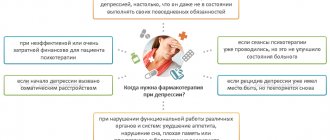PED therapy allows patients with multiple sclerosis to live a full life
On the eve of the International Day of Multiple Sclerosis, the head of the specialized medical care department of polyclinic No. 5 of branch No. 2 of the City Hospital No. 1 named after. N.I. Pirogova”, chief freelance specialist neurologist, candidate of medical sciences Elena Tokareva
told a correspondent of the Center for Public Health and Medical Prevention about the disease, the diagnosis of multiple sclerosis in Sevastopol, the number of cases and the possibilities of its treatment.
By multiple sclerosis, ordinary people often understand memory impairment in old age. But that's not true.
How does this disease manifest itself and why is it dangerous?
Multiple sclerosis is a chronic, progressive autoimmune disease that affects the myelin sheath of nerve fibers in the brain and spinal cord.
The disease received its name because of its distinctive pathoanatomical feature - the presence of sclerosis foci scattered throughout the central nervous system without a specific localization, that is, the replacement of normal nervous tissue with connective tissue.
The morphological feature of the disease is the formation of so-called multiple sclerosis plaques - foci of destruction of the white matter of the brain and spinal cord.
This is a disease of the young. The peak incidence occurs during the most active period of a person’s life – 20-40 years. However, the disease can also develop in children.
Symptoms of multiple sclerosis debut in different ways - depending on the location of the lesions in the brain and spinal cord, its degree and disturbances in the conduction of impulses. Multiple sclerosis may be indicated by paresis and paralysis - partial or complete lack of movement in the limbs, muscle hypertonicity, obsessive and involuntary movements, and visual impairment.
The disease causes sensory disturbances with tingling and numbness in the fingers and toes, a feeling of unsteadiness of the ground under your feet, “wobbly” legs and other problems with movement, fatigue, fatigue.
What causes this disease?
Most often, multiple sclerosis occurs in residents of Northern Europe and Canada. The frequency of cases increases to the north.
This is due to sunlight. Under the influence of ultraviolet light, vitamin D is synthesized in the skin, which is then converted into its active form - calcitriol. Low vitamin D levels increase the likelihood of developing multiple sclerosis.
However, this does not mean that taking vitamin D regularly will prevent the disease. Any medications should be taken only after the recommendation of the attending physician.
However, patients with multiple sclerosis who received this vitamin as a dietary supplement experienced improvement in their disease. Various viruses can also increase the risk of developing the disease, in particular, the Epstein-Barr virus, cytomegalovirus, and some retro- and polyomaviruses. Smoking also increases the risk of the disease.
How is multiple sclerosis diagnosed in Sevastopol?
The most important way is to conduct an MRI, where we see foci of inflammation, foci of demyelination on sections in certain programs.
We can only rely on the clinical picture and MRI, as well as our own experience when making this diagnosis.
In Sevastopol, about 350 people suffer from multiple sclerosis, of which 320 people receive therapy - DMT drugs, which affect the course of the disease and create a stable quality of life
. Our patients receive medications under a special program 14VZN. The state fully provides them with all necessary medicines.
What results can be achieved in the treatment of multiple sclerosis?
Multiple sclerosis requires lifelong treatment. Today, the treatment effect is achieved through drugs that modify the course of multiple sclerosis, abbreviated as MSD. Their actions are aimed at creating stable and long-term remission in patients.
Thanks to DMT therapy, it is possible to reduce the number of exacerbations and preserve healthy nerve tissue. Each exacerbation causes damage to nerve tissue, which lasts for the patient for life.
It is almost impossible to restore this damaged tissue, so all patients must be committed to treatment and must constantly contact the “multiple sclerosis” office or their neurologist at their place of residence.
Constant monitoring and adherence to therapy are the key to active longevity and complete control over the disease.
Interviewed by A. Pribilova
What are PITRS
Since MS is an autoimmune disease, it involves a malfunction of the immune system.
Scientists have come to the conclusion that the basis of treatment should include immunomodulatory agents, the principle of which is based on the influence on the activity of the immune system. The DMT group includes medications containing the following active ingredients:
- interferon beta-1a;
- interferon beta-1b;
- glatiramer acetate;
- teriflunamide;
- fingolimod;
- mitoxantrone;
- natalizumab.
Mechanism of action
Despite the general focus, the mechanisms of action of various drugs differ:
- Interferons beta have a general, nonspecific immunomodulatory effect.
- Glatiramer acetate has a specific effect: competitive replacement of myelin antigens at the sites of connection with molecules of the major histocompatibility complex. The result of the drug is inhibition of T1 lymphocytes and activation of T2 lymphocytes, the latter have a positive effect on the course of the disease and contribute to anti-inflammatory and neuroprotective processes.
- Teriflunomide inhibits the division of cells of the immune system, leading to a decrease in the number of circulating B and T cells. The drug has immunomodulatory and anti-inflammatory properties.
- Natalizumab is a recombinant monoclonal antibody against adhesion molecules. The action is aimed at slowing down the passage of lymphocytes through the blood-brain barrier, suppressing the activity of T-lymphocytes in areas of axonal damage and reducing the likelihood of recurrent inflammation in damaged areas.
- The action of Fingolimod is based on innovation: blocking sphingosine-phosphate receptors of lymphocytes, as a result of which lymphocytes do not leave the lymph nodes and, accordingly, the number of auto-aggressive T cells in the blood decreases; the drug also penetrates the brain and affects sphingosine-1-phosphate receptors of glial cells and neurons.
- Mitoxantrone creates bonds with nuclear DNA. The mechanism of its action is not fully understood. It is known that the drug has a cytotoxic effect on both proliferating and non-proliferating human cells, that is, its effect is not related to the phase of the cell cycle
PITRS first and second lines
As a rule, treatment of multiple sclerosis begins with first-line DMT:
In the initial stage of treatment the following is used:
- interferon beta-1a – subcutaneously (three times a week);
- interferon beta-1a – used intramuscularly (once a week);
- interferon beta-1b – subcutaneously (every other day);
- glatiramer acetate – subcutaneously (every day);
- teriflunamide tablets (every day).
The effect of first-line drugs has been studied better than the second. Their effectiveness is high, but in some cases insufficient, which gives the doctor reasons to prescribe second-line DMTs:
- Natalizumab – intravenous drip (once every 4 weeks);
- Fingolimod – tablets (daily).
To treat patients with high activity of relapsing multiple sclerosis, accompanied by rapid disability, when it is impossible to use alternative therapeutic agents, antineoplastic drugs are used (for example, Mitoxantrone - intravenous drip once every three months).
The main side effect of first-line DMTs is mental disorders manifested by depressive states. It is also possible that the drugs have a negative effect on the circulatory, hepatobiliary, and central nervous systems.
Second-line medications are characterized by several severe side effects - damage to the heart muscle, heart rhythm disturbances, and the appearance of progressive multifocal leukodystrophy.
When choosing second-line drugs, the doctor resorts to a careful analysis of the possible risks associated with their prescription. The patient is advised to undergo regular medical supervision.
Practical application experience
According to the results of one of the scientific studies, “Patient Assessment of the Effectiveness of Multiple Sclerosis Therapy,” the results of which were published in 2021, the main indicators of the effectiveness of treatment are the absence of an aggravated clinical picture and progression of disorders of the nervous system.
At the same time, the subjective opinion of patients about the effectiveness of treatment was found more often than the effectiveness was confirmed by diagnostic methods. Over three years, the studied patients noted in 57% of cases a decrease in the number of exacerbations from 1 to 3 and in 24% of cases the absence of an aggravated clinical picture. All of these people find the therapy effective.
The study established a threshold for low treatment effectiveness: more than three episodes of exacerbation of the clinical picture in three years.
The study also found that subjective assessments of the positive effect of MS treatment directly depend on the relationship with the attending physician. Patients who indicated that their vision of the effect of treatment coincided with the goals set by the attending physician generally rated the results of therapy highly. Treatment was more often considered ineffective by those patients whose opinions differed from the goals of the doctors.
Permitted PITRS in Russia
When medications are not used
The following contraindications are common to all PEDs:
- hypersensitivity to the active substance or auxiliary components of the drug;
- decompensated or severe forms of liver disease;
- pregnancy, breastfeeding.
Additional contraindications for interferons:
- primary progressive forms of MS;
- the presence of severe depression, thoughts of suicide, mental disorders;
- heart disease in severe forms.
Additional contraindications for glatiramer acetate:
- panic attacks.
Additional contraindications for teriflunamide:
- severe immunodeficiency states;
- hematopoietic pathologies;
- renal decompensation;
- acute infectious diseases in severe forms;
- a sharp decrease in protein in the blood;
- age up to 18 years.
Typical additional contraindications for second-line DMTs:
- immunodeficiency states;
- the possibility of infection of the patient with opportunistic microorganisms;
- cancer tumors, except basal cell carcinoma;
- progressive multifocal leukoencephalopathy;
- simultaneous use of first-line DMTs;
- childhood and adolescence.
You should know that the prescription of DMTs to children under 12 years of age must be approved by a medical commission; when choosing drugs, the results of diagnostic studies must be taken into account. Parents/legal guardians are informed of the possible risks and consent to prescribing medications to the child is obtained.










